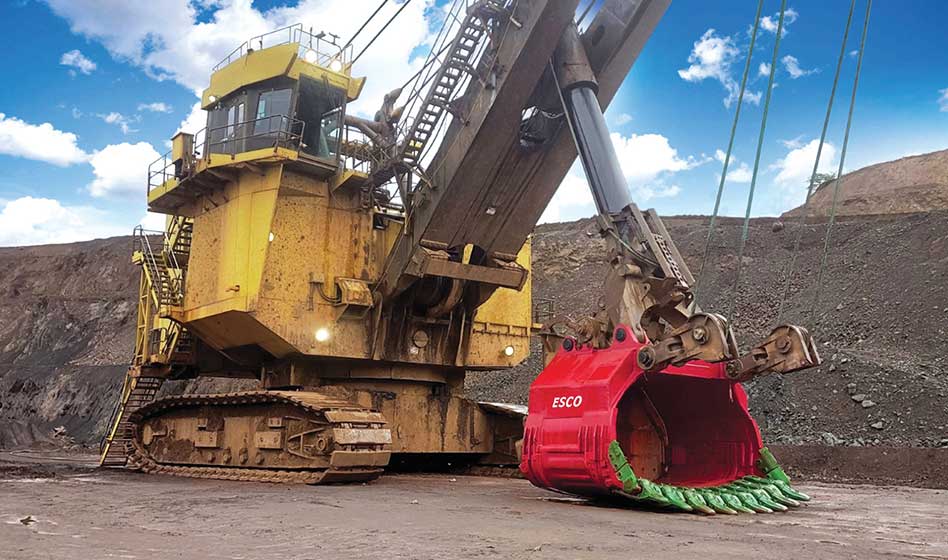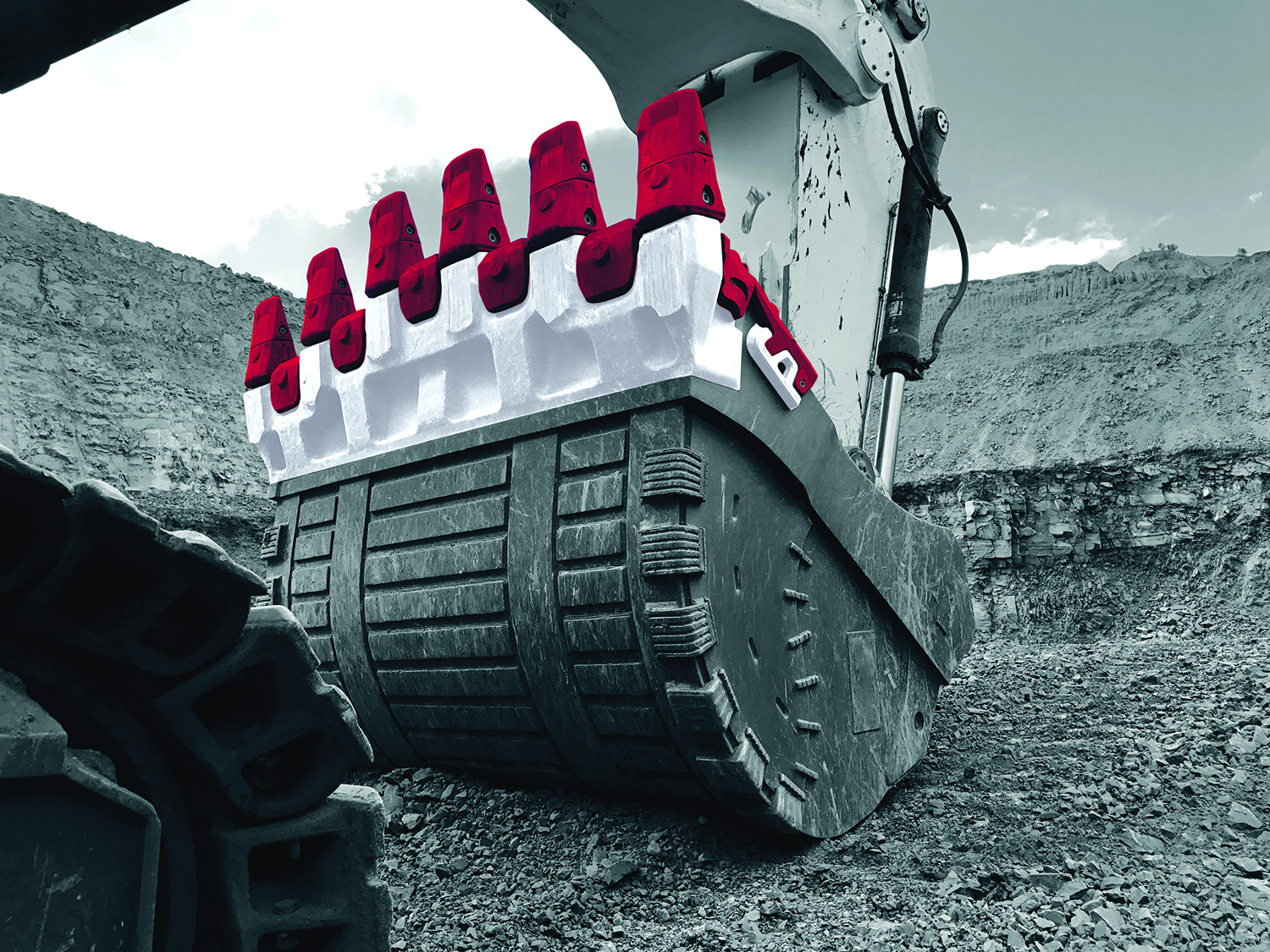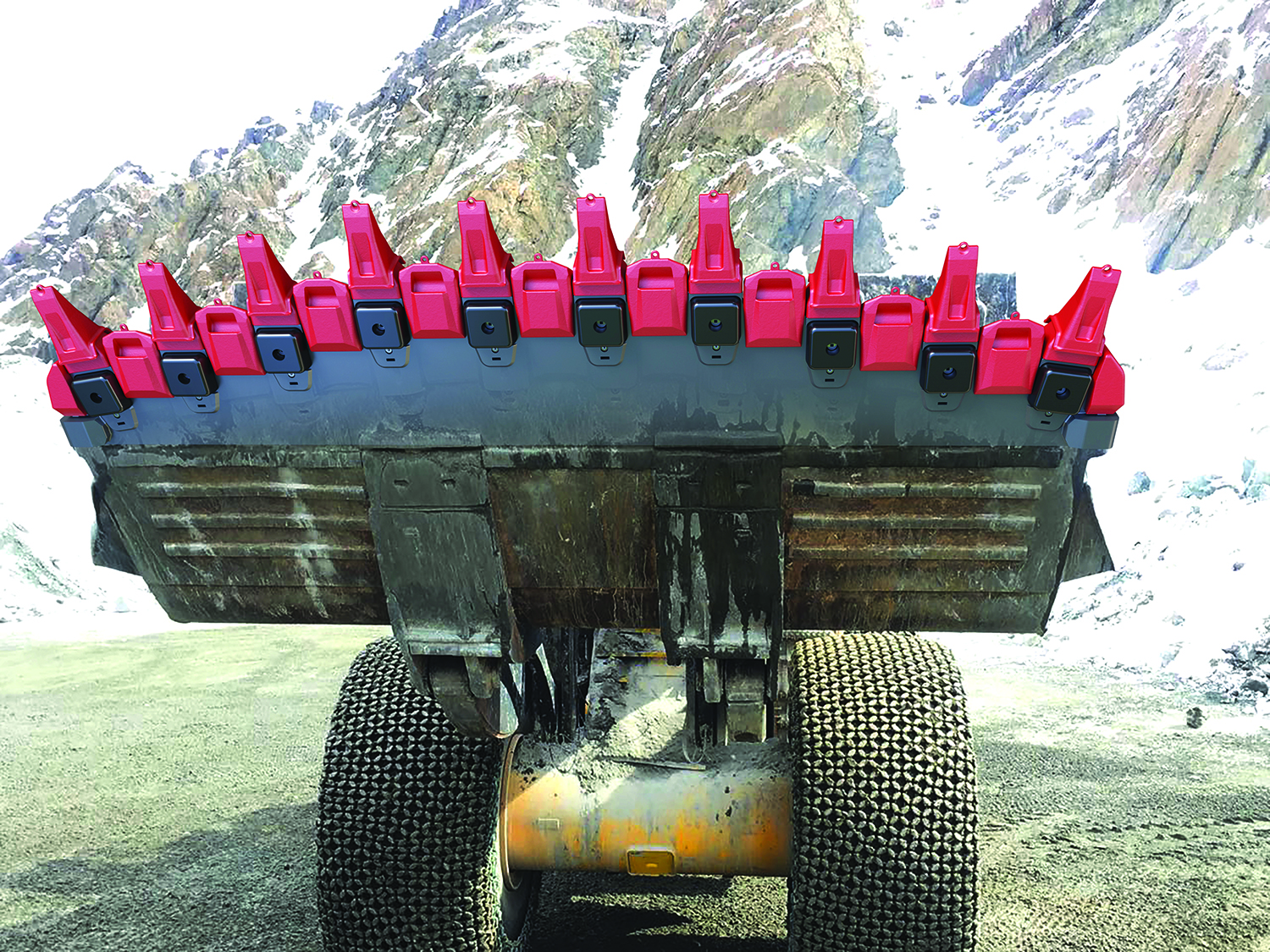
The new Nexsys GET system offers improved production and reduced maintenance. (Photo: Weir ESCO)
Loss detection systems could lead to a better understanding of wear
By Steve Fiscor, Editor-in-Chief
The primary loading tools in the pit, the rope shovels and hydraulic excavators, crowd the bank with each pass. This repetitive, grinding action takes a toll on the high wear areas of the dipper or the bucket, including the lip and the teeth. Left unchecked, a broken or missing tooth could lead to unplanned production downtime and even catastrophic failure if a tooth or a shroud found its way to the crusher.
One aspect of improving the life of ground engaging tools (GET) is to properly match attachments with the hardness and abrasiveness of the geologic formation. Iron ore represents the high end of the hardness spectrum followed by copper and gold. Coal and oil sands would be softer, yet abrasive applications. Obviously more metal on the tools helps them last longer, but tooth geometry is also important.
While wear is unavoidable when steel engages rock, a regular GET management plan can prolong the life of the equipment. Identifying wear is key and this could range from something as simple as a weekly visual inspection to high tech digital solutions that monitor GET health.
Changing teeth on a dipper or a bucket usually requires human interaction and brute force, but that’s about to change. Suppliers have developed systems that allow teeth to be changed easily and frequently and new equipment has been developed to assist in the process.
E&MJ spoke with three leading GET suppliers, CR Powered by Epiroc, MTG and Weir ESCO to get the scoop on GET.
Lead Times Have Improved
The supply lines to manufacture and distribute GET have recovered from logistical disruptions caused by the pandemic. Small scale, but manageable problems persist. Terrorist activities in the Middle East and a drought in the Panama Canal region are forcing transport companies to reroute ships around Cape Horn and the Cape of Good Hope.
Of the major GET manufacturers, MTG’s facilities are located closest to tensions in the Middle East. “The situation in the Middle East is affecting international traffic of goods, however, our deliveries have not suffered delays thanks to the distribution centers we have on several continents,” said Ángel Martínez, mining product manager for MTG.
Joe Lindekugel, vice president-North America, CR, agrees. Logistics are far as acquiring materials and delivering GET and wear materials has normalized, he explained “Even when the supply chain was kind of strung out and shipping lanes were disrupted, we simply accounted for that by carrying more inventory to keep the mines operating,” Lindekugel said. “We did not stock out a single customer. We worked hard with advanced planning. We bought material in advance to ensure we didn’t have any shortages anywhere. We had to use a little air freight to fill in the gaps. Now the lead times have been reduced and we do not need to carry as much inventory as we were. We now plan and adjust inventory levels accordingly.”
While most of the supply chain and logistics challenges Weir ESCO said it faced have now fully recovered, ensuring uninterrupted supply remains crucial. The company has an established global network and multi-sourced parts availability. “Whether it’s due to war, tariffs, natural disasters or geopolitical issues, anticipating and responding to these challenges is essential for all global GET players,” said Michael Funke, vice president global supply chain, Weir ESCO. “Weir ESCO has invested in internal digital supply chain capabilities over the past five years, introducing new planning and logistics tools to leverage our global distribution network, supply chain talent and internal and external supply base.”
Standardization Could Be the Answer
According to Weir ESCO, a lot of the hassles associated with maintaining inventory could be reduced through standardization. By standardizing GET across fleets, performance could be improved by enabling interchangeability between machines. “The Nemisys GET system from Weir ESCO offers ultimate flexibility, with a wide selection of alternative components available for temporary replacement while awaiting additional supply,” said Yesenia Meraz-Torres, global mining GET product manager for Weir ESCO.
As a leading supplier of GET and buckets for mining applications, Weir ESCO’s expertise includes matching its buckets with premium Nemisys lip systems, which are currently deployed on more than 1,200 machines worldwide. This pairing, according to Weir ESCO, ensures sites benefit from superior penetration, loading efficiency, extended wear-life and unmatched reliability.
Even if a new bucket is unnecessary, the Nemisys lip system can seamlessly integrate with existing ESCO, OEM or competitor buckets, offering a versatile upgrade solution, explained Meraz-Torres.
“When operating in aggressive, hard digging conditions Weir ESCO recommends using a combination of a premium Nemisys XHD lip system paired with an ESCO XHD bucket,” Meraz-Torres said. “With an XHD bucket, customers will benefit from a bucket design specifically engineered for the type of application. In addition, the bucket will be equipped with a wear package that will help extend overall bucket life by protecting its structure.
Pairing an XHD bucket with a premium Nemisys XHD lip system will yield the highest performance for the mine, she explained. “For machines in the 350-ton class or higher, the Nemisys product line offers a full suite of parts, including XHD intermediate adapters and XHD shrouds,” Meraz-Torres said. “Both of those parts offer extended bottom leg wear material, further helping protect the lower structure of the lip. Nemisys point geometries help optimize the performance of the leading edge of the system.
As an option, she said the XHD components could be combined with a heavy-style point to deliver the best system reliability, wear life and lip maintenance.
Mechanically attached adapters continue to be the primary choice for most of the mines operating rope shovels. However, Weir ESCO noted that there has been an increase in adoption of the integral nose cast lip option for rope shovels. “Mine operators running the integral nose cast lip system have seen a reduction in system dig energy and improved productivity,” Meraz-Torres said. “The streamlined system not only allows for a higher payload in the bucket it also yields higher productivity and operating efficiency. Those that have switched to an integral nose cast lip are also benefiting from the faster and safer GET changeouts that the Nemisys system is able to deliver.”
Enhancing the Range of GET Options
Weir ESCO said the Nemisys system continues to evolve, enhancing the range of GET options optimized for smaller mining machines. A recent enhancement includes the integration of sealed locks across all tooth offerings, facilitating easier removal even in the most challenging environments with severe impacted fines.
Weir ESCO has also introduced the ShovelMetrics Gen 3 system with the help of Motion Metrics. This technology features a stereoscopic 3D camera equipped with LED lighting, enabling mines to capture high-quality images and data in poor visibility conditions.
With the integration of Motion Metrics, Weir ESCO now offers customers advanced tools for equipment management. Motion Metrics provides a comprehensive suite of products, from GET detection to fragmentation analysis.
“When combined with Weir ESCO attachments and the GET lip system, Motion Metrics technologies represent a cutting-edge suite of systems designed to usher in a new era of safer, more sustainable and intelligent mining practices,” Meraz-Torres said. “By leveraging Motion Metric systems, mine sites can proactively reduce maintenance requirements, minimize downtime and optimize operational efficiency.”
Weir ESCO’s latest advancement is the upcoming launch of the Nexsys mining system for rope shovels, Meraz-Torres explained.. “This new system is engineered to deliver enhanced upfront value, significant performance improvements, and extended service life,” she said.
The slimmer profile of the ESCO Nexsys mining system enables better penetration and loading capabilities. It weighs up to 10% less than the Whisler Plus system. Its design simplifies rebuild requirements, minimizing downtime. Enhanced adapter protection extends system life, reducing maintenance needs.
“The Nexsys system’s durability reduces the risk of unplanned downtime, ensuring continuous operation,” said Meraz-Torres. “Our newly developed tooth system requires easier and fewer point changes, optimizing operational efficiency.”
Overall, she explained, the Nexsys System provides increased sustainability over previous systems, aligning with environmental and operational goals.

Outstanding steel properties extend the life of the TERRA cast lip system. (Photo: MTG)
MTG Adds Production Capacity
In 2021, MTG announced a EUR12 million ($13 million) investment in foundry improvements. “Today, the project is currently in full swing and aims to respond to MTG’s worldwide growth, an increasing market demand and the need for a carbon-neutral footprint,” Martínez said. “The entire project will increase MTG’s total production capacity by 50% and its foundry size by more than 30%. Existing production facilities are being modernized by state-of-the-art machinery and digitalized processes to increase efficiency, speed, and competitiveness. The new facilities will expand production capacity and capabilities providing more manufacturing flexibility. This includes the molding and casting sections to produce a wide range of GET products.”
One of MTG’s most advanced mining GET solution is the TERRA cast lip. The key benefits of the cast lip system are higher productivity, reduced operational costs, longer operational times, and less downtime, Martinez explained. “This is possible thanks to the combination of a very sophisticated design together with outstanding steel properties,” he said.
The TERRA cast lip system’s slim design offers better penetration. “On average it has about 19% higher resistance while 4% slimmer than other cast lips,” Martinez said. “Optimal distribution of wear material has reduced the weight by 5% over comparable systems. Critical areas of the cast lip are protected by TWINMET and PROMET. A recent finite element analysis (FEA) shows uniform and well distributed stress along the entire width of the cast lip.”
Reports from the field have validated TERRA’s resistance and durability in extreme conditions. The TERRA cast lips were able to withstand tough iron ore applications in Australia for more than 15,000 hours and only required a 5-hour nose rebuild and gauging. The reduction in time required to rebuild and gauge helped the mine to significantly reduce maintenance costs, Martinez explained.
MTG developed a GET Detection System and it is now running at several sites now. “Since it was launched, our first in-house developed digital solution has created great interest in the market,” Martinez said. “The sector is moving toward the “digital mine,” and the GET Detection solution is totally aligned with this market trend.”
The system is based on sensor technology that allows MTG to provide real time monitoring of the entire bucket configuration. It does not need a direct line of view to trigger an alarm, which enables immediate action to prevent any further damage and allows the machine to quickly return to production.
“With our GET Detection System, we solve the mining challenge to avoid dangerous repair works, minimize unplanned downtimes and reduce production losses,” Martinez said. “It detects a potential GET detachment in less than 3 seconds with a high level of accuracy, preventing the worst-case scenario of having a GET part in the crusher. This is something that mines consider a priority. Safety is first, but we all know what it means in economic terms when a crusher stops due to the fall of a steel part and how complicated and risky it can be to solve this operational issue.”
Tooth designs have evolved a lot over the years. As a specialist with more than 65 years of designing and manufacturing GET and more than 430 patents in 35 countries, MTG said it actively contributing to this evolution. “We are constantly improving our GET’s safety, productivity and reliability capabilities from a customer-centric perspective using the most advanced tools.”
To evaluate the resistance and improve the reliability of the products, MTG has been applying FEA for decades. To maximize the productivity of the machine, Discrete Element Modelling (DEM) is now helping the company create slimmer teeth and cast lip profiles. “We also run periodic lab tests to validate new concepts before testing them in the field,” Martinez said. “Additionally, we maintain a close relationship with our customers to constantly run field tests to receive market feedback and to optimize product designs. Each of our systems consists of a wide range of tooth profiles that offer efficient solutions for each type of application. On top of that, we are putting a special focus on user-friendliness. For example, a QR-code integrated in VEEMET and VEEMET Rope Shovels, the latest tooth system, provides up-to-date product and service information always at the customers’ fingertips.”
MTG said it is currently working on several new projects that include both digital and new GET solutions. “Our dedicated product development teams are constantly working on new systems and solutions with optimized designs and enhanced locking systems,” Martinez said. “We are continuously performing tests of new concepts. The last example is the new MTG Systems/VEEMET product family. Enhanced stability, optimized locking and improved penetration are, amongst many, its most important benefits. The V-shaped fitting and the optimized locking with reinforced pin provide a better stability that reduces plastic deformation and maximizes wear life.”
Moreover, Martinez explained, MTG’s digital team is continuously working on additional functionalities related to safety, productivity, and customer service.

Cast lips with integrated noses can also be used for wheel loaders. (Photo: CR)
CR Extends the Life of the Lip
For iron ore, which tends to be the hardest ore, CR recommends a longer tooth with a self-sharpening profile. The longer tooth allows more wear time to establish a regular interval for tooth changes, Lindekugel explained. “Copper mines tend to go with a bit shorter tooth with a little bit different profile,” Lindekugel said. “They wear differently even though it’s a harder rock application. For gold, we recommend heavy-duty shrouds and heavy-duty teeth as well because of fast wear rates. It doesn’t necessarily have to last forever, but if it doesn’t last until the next scheduled maintenance interval, it disrupts the workflow.
Conditions are site-specific, Michael Meidow, vice president-technical support, CR explained, and maintenance practices vary between mine sites. “Some mines have a routine like every Wednesday or every 10 days,” he said. “Others see two worn teeth and decide to change them right away. Some use constant monitoring and change the whole lip at one time.” Another practice is to swap the teeth on the lip that are wearing faster with those that are not.
“Whatever the practice CR has different tooth and shroud profiles that can give them more or less life to match what they’re doing and how they’re maintaining those lips,” Lindekugel said.
CR sees more mines considering its integrated nose cast lip options for hydraulic excavators, Meidow said. “Dippers are a very mature product and the lips typically last much, much longer than the lips on excavator buckets,” Meidow said. “Because of that, the miners try to maintain the lips on rope shovels. The decision to cut the lip from a dipper is not an easy one. Most would rather stay with the adapter system.”
For hydraulic excavators, CR has cast lips for the 100 ton class and higher. “The lips get changed out more frequently, like three and five years compared to 15 years for a dipper,” Meidow said.
CR also carries GET for wheel loaders. “We’re the only ones that have cast lips with integrated noses for wheel loaders,” Meidow said. “The cast lip on those machines have performed well. They require less maintenance compared to a plate lip with weld-on adapters. With wheel loaders, there is the repetitive motion and the moments created at the tip that causes the lip to start to crack at the weld joint, especially in the heat affected zone of those welds. That needs to be repaired all the time. The cast lip eliminates the inventory of adapters mines must carry because they are already integrated into that system.”
The main point is reduced lip repair and maintenance, Lindekugel said. “Whether it’s plate or cast, the lip will be cut out in three to five years no matter what,” he said. “When the lip has an integral nose, the mine does not need all those extra parts and they basically renew it when they replace the lip anyway.”
As far as notable changes in the past few years, Lindekugel said most of the change has been with locking systems and the ability to sense tooth loss. “CR has developed the GET Trakka system that detects GET loss like teeth and shrouds,” he said. “We can also recover them. As far as I know, we’re the only people with that capability.” The system relies on a sensor embedded in the GET.
“We are always trying to improve locking systems to make it easier to install and remove GET and make it perform better,” Lindekugel said. “The materials… they are what they are. We make very hard materials, which tend to wear longer, and we try to balance hardness versus brittleness. There are trade-offs with ductility and toughness.”
CR is also looking at ways to remove the human from the equation when it comes to changing GET, Meidow explained. “We have the GRIPAssist system,” he said. “This is a tool mounted in the front of a skid-steer loader and the skid-steer operator can then change the teeth out. It’s a universal system; it works with our GET and others.”
Looking toward the future, CR said it will improve availability by making products that last longer, by making locks that are easier to install and remove and finding ways to handle GET safely. “We will continue to move away from hammer type systems, but it will take time to develop a product that can survive in the mining environment, which is also quick to remove and assemble,” Lindekugel said.
Lindekugel also sees opportunities with the sensors embedded in the GET and the digital data it could generate. In the future, the sensor could inform maintenance about the teeth or the shrouds or whatever needs to be replaced. Eventually, data from the sensor could forecast needs and assist with inventory management.






